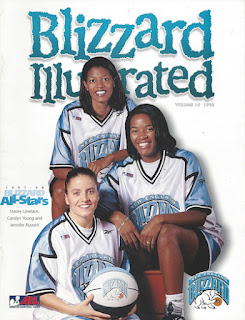Remember Blizzard and Whalers, but Sun's days are numbered
April 13, 1997 is a date that lives in infamy if you are a Connecticut sports fan. That marked the final Hartford Whalers game in history and the Hartford Civic Center held a memorial service for the beloved Whale that night, complete with the requisite grief and mourning, as their 26-year run in the NHL and WHA came to an end. Rest in peace, Brass Bonanza.
But there is another date just 20 months later lost to history that should carry more significance in Connecticut women’s basketball lore: December 22, 1998.
It was on that date that the American Basketball League announced it was ceasing operations effective immediately, ending what appeared to be the best chance for professional women’s basketball in the United States less than halfway through its third season.
If you’re too young or it’s just a little painful to recollect, the ABL launched before the WNBA and for a time - unfortunately very short-lived - that the ABL (and not the WNBA) was going to propel professional women’s sports into the mainstream. It had seven members of the U.S. 1996 team that had just won the gold medal in Atlanta, most of the top college players, and strategically had its team in the top drawing college markets.
Of course, one of those was in Connecticut with the New England Blizzard (who did play a lot of its games just over the border in Springfield, Mass. its first season). The Blizzard were never very successful on the court, but still led the league in attendance, led by a name Sun fans know well, Jennifer Rizzotti.
As you probably could have deduced (faster than the ABL owners), once the WNBA jumped on board, it was going to be almost impossible for the ABL, especially with the salaries they were paying. Unlike the WNBA, the ABL played with a traditional basketball calendar in the winter and finding someone to show their games on television was just never going to happen in that era.
And so, it died, and the impact hit harder in Connecticut than anywhere else. (Amazingly, its operating manual still survives and is quite the read if you have time.)
Four years later, a miracle, the Orlando Miracle relocated to Connecticut. Even in 2002, the future of the WNBA was in serious doubt, and as Dom Amore of the Hartford Courant wrote this week, the league owes the Mohegan Tribe a big debt of gratitude for stepping in when they did. The arena was the perfect size, there would always be a loyal fanbase, and there was no way they would go bankrupt any time soon.
There are major differences to what befell the Whalers in 1997 and what sure seems to be the Sun’s fate after the 2025 campaign, but there are also hard to ignore similarities. The NHL had recently moved to Miami, Tampa, and Dallas, and was looking at other big southern markets with dollar signs in their eyes as the NHL would go through a period where the league was never more popular (you can argue it peaked then, really).
Realistically, Whaler fans knew in their heads that Hartford just wouldn’t be able to keep up, even if their hears argued vehemently, and their merchandise was so beloved that it still ranks near the top of the NHL sales charts. Maybe if they built a new arena and reshaped downtown. Maybe if they paired with UConn to put state of the art practice facilities up.
But that was never going to happen. And so off to North Carolina they went.
With the Sun’s sale imminent, realistically we know that that - if it isn’t too big already - the WNBA will soon be too large for Mohegan Sun Arena and probably Connecticut as a whole. Prices being thrown around for the franchise range between $80-$100 million, and it’s possible it might be more before all is said and done. There was a time not so long ago when you could barely give one away, with the fear of the league collapsing always in the back of everyone’s minds.
This league isn’t going anywhere except up in the near future, and with a new collective bargaining agreement hopefully forthcoming soon and a $2.2 billion television deal ready to start in 2026, it’s probably time for the Sun to ship on up to Boston.
That won’t make it any less painful when the final announcement comes and the last game is played at Mohegan Sun Arena (if you need to know, the season finale is Sept. 10 against Atlanta). Although it will likely never result in a WNBA title, there were the sellout crowds, the playoff runs, and just seeing the best basketball players in the world every summer close in an intimate setting for fairly cheap prices.
There, of course, remains a “so you’re saying there’s a chance” odds that someone steps in, buys the Sun, renovates everything, puts in a state-of-the-art practice facility, and the Sun become a model WNBA franchise for the next few decades.
It also remains pretty crappy that Boston will likely grab the Sun and rebrand them, the same Boston that wouldn’t touch a WNBA franchise in 2002 and for two decades after with a 10-foot rim, consistently finding excuses (most of them monetary) why they didn’t want TD Garden’s dates blocked off for a league they said no one cared about.
But, just like the Whalers three decades ago, the math just doesn’t math anymore to keep the Connecticut Sun where they are going forward.
So, like we have every other season before it, let’s enjoy the 2025 ride, wherever it takes us. And do not go gentle into that good night.
Hopefully, I'll see you Sunday afternoon.


Comments
Post a Comment